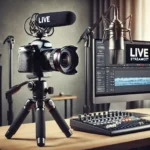Live streaming has become a vital tool for content creators, businesses, gamers, and educators. Whether you’re hosting virtual events, engaging with your audience in real-time, or broadcasting gameplay, the right camera can dramatically improve the quality of your streams. Choosing the best camera for live streaming can be overwhelming with so many options on the market, each boasting various features. This guide will help you make an informed decision by focusing on essential considerations.
1. Define Your Purpose and Platform
The first step in choosing the best camera for live streaming is understanding your purpose and platform. Are you a gamer streaming on Twitch? A business professional hosting webinars on LinkedIn? A content creator on YouTube? Each platform has unique requirements and audience expectations.
For example:
- Twitch often prioritizes smooth frame rates for gameplay streams.
- YouTube Live benefits from high-resolution video for professional-quality streams.
- Instagram or TikTok Live may not require a high-end camera but something mobile and easy to connect.
Your purpose will shape what features to prioritize in your camera.
2. Understand Video Resolution Requirements
Resolution is a critical factor to consider to ensure crystal-clear streams. Here’s a breakdown of common resolution options:
- 720p (HD): Suitable for casual streamers with limited internet bandwidth.
- 1080p (Full HD): A standard option for professionals and businesses, offering clear and detailed video.
- 4K Ultra HD: Best for high-end production and future-proofing your content, though it requires a strong internet connection and compatible streaming platforms.
While 4K cameras are appealing, consider whether your viewers will benefit from that level of quality. For platforms like Twitch, 1080p might be sufficient.
3. Evaluate Frame Rates
Frame rate refers to how many frames per second (FPS) the camera captures. A higher frame rate results in smoother video, especially for fast movements. The optimal FPS depends on your content:
- 30 FPS: Ideal for most purposes, including business webinars or casual streams.
- 60 FPS: Preferred for gaming, action-packed streams, or dynamic content.
Ensure the camera you choose supports the frame rate needed for your type of live streaming.
4. Assess Connectivity Options
Seamless connectivity is crucial for a good live streaming experience. Different cameras have varying connectivity options:
- USB: Popular with webcams; plug-and-play simplicity.
- HDMI: Found in DSLR and mirrorless cameras, offering high-quality video output. Require a video capture card for live streaming.
- Wi-Fi: Great for wireless streaming where flexibility is needed.
Choose a camera with connectivity that aligns with your setup and is compatible with your streaming software.
5. Webcam vs. DSLR/Mirrorless Cameras
When selecting a camera, you’ll likely consider either webcams or DSLR/mirrorless options. Each has its advantages:
Webcams:
- Affordable and easy to use.
- Built for live streaming, require little to no setup.
- Compact and portable.
- Example: Logitech StreamCam, Razer Kiyo.
DSLR/Mirrorless Cameras:
- Superior video quality and depth of field.
- Versatile: can be used for photography as well.
- Offer manual controls for professional streaming.
- Example: Sony Alpha series, Canon EOS M50.
If you’re on a budget or need a simple solution, a high-quality webcam is a great starting point. If you seek advanced features, opt for mirrorless or DSLR cameras.
6. Check Autofocus and Low-Light Performance
Good autofocus ensures your stream remains sharp even as you move. This is particularly important for active streamers who frequently change positions.
Low-light performance is another key factor for indoor or nighttime streaming. Cameras with a larger sensor and a low aperture lens perform better in dim light. Compare models based on these features to ensure consistent video quality.
7. Portability and Design
Consider the camera’s size, weight, and design. If you travel frequently or prefer a clutter-free desk setup, opt for compact and lightweight cameras. For instance:
- Webcams: Extremely portable, and can be clipped directly onto monitors.
- Mirrorless Cameras: Generally lightweight, offering portability without compromising quality.
Balance your need for portability with your desired video resolution and features.
8. Budget Considerations
Determine your budget before you start shopping. Fortunately, there are excellent live-streaming cameras for every price range:
- Under $100: Budget-friendly webcams such as the Logitech C920.
- $100-$500: Mid-range options like the Elgato Facecam or entry-level mirrorless cameras.
- $500+: High-end DSLR or mirrorless cameras for professionals.
Remember to factor in additional costs like tripods, lighting, and audio equipment as part of your live-streaming setup.
9. Read Reviews and Watch Sample Videos
Finally, make informed decisions by reading reviews and watching sample videos from other streamers. You’ll get insights into real-world performance and avoid investing in a camera that may not meet your expectations.
Conclusion
The best camera for live streaming ultimately depends on your specific needs, platform, budget, and preferences. By evaluating factors like resolution, frame rate, connectivity options, and portability, you’ll be well-equipped to pick the perfect camera. Whether you’re just starting out or upgrading your setup, this guide ensures you’ll make a choice that enhances your live streaming experience. Happy streaming!
